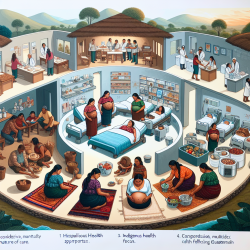Introduction
In the remote highlands of Guatemala, Indigenous women face significant barriers to accessing quality maternal healthcare. These barriers, rooted in economic, cultural, and linguistic challenges, contribute to a maternal mortality ratio that is more than double that of non-Indigenous women. A recent study published in the International Journal for Equity in Health highlights a promising approach to addressing these inequities through the use of Community Birthing Centers.
The CBIO+ Approach
The study focuses on the CBIO+ Approach implemented by Curamericas/Guatemala, which includes the establishment of Community Birthing Centers known as Casas Maternas Rurales. These centers are community-built, -owned, and -operated, providing culturally sensitive and accessible care to Indigenous women. The research examines how these centers manage pregnancy complications and the decision-making processes involved in handling such cases.
Key Findings
Between 2009 and 2016, 1,378 women sought delivery-related care at these centers. Of the 211 peripartum complications encountered, 42.2% were successfully managed on-site, while 57.8% were referred to higher-level care. The centers achieved a maternal mortality ratio of 72.6 per 100,000 live births, significantly lower than the national average for Indigenous women.
Factors for Success
The study attributes the centers' success to several factors:
- Frequent, high-quality training for staff.
- Task-shifting and a supportive network for consultative support.
- A collaborative atmosphere among staff members.
These elements create an environment where lower-level health workers can effectively manage complications, supported by ongoing training and a strong organizational culture.
Challenges and Barriers
Despite these successes, significant barriers remain. Families often reject referrals due to financial constraints, fear of disrespectful treatment at higher-level facilities, and cultural preferences for home births. The study highlights the need for systemic changes to address these barriers and improve compliance with referrals.
Implications for Practitioners
For practitioners working in similar settings, the findings offer valuable insights into improving maternal health outcomes. By implementing community-driven, culturally sensitive approaches, practitioners can enhance the accessibility and quality of care for marginalized populations. The study also underscores the importance of continuous training and support for healthcare workers, empowering them to manage complications effectively.
Conclusion
The Community Birthing Centers in rural Guatemala demonstrate the potential of localized, culturally appropriate healthcare solutions in reducing maternal mortality. As practitioners, embracing such models can lead to improved health outcomes and greater equity in maternal healthcare.
To read the original research paper, please follow this link: Reducing inequities in maternal and child health in rural Guatemala through the CBIO+ Approach of Curamericas: 6. Management of pregnancy complications at Community Birthing Centers (Casas Maternas Rurales).










